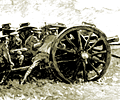














|
LESSON 12
Propaganda
Grade: 10
Time: one period (40 minutes)
Expectations:
Students will:
- use appropriate vocabulary to describe their inquiries and observations;
- formulate questions to facilitate research (e.g., the changing role
of women in the workforce), using a variety of sources;
- analyze, synthesize, and evaluate historical information; locate
information using a variety of sources;
- analyze and describe conflicting points of view;
- communicate the results of inquiries for specific purposes and audiences,
using media works, political cartoons, oral presentations, written notes,
reports, posters, tables, charts, and / or graphs;
- differentiate between bias, inference, and fact.
Preparation:
- Bristle Board or Manila Tag (enough pieces for approximately six
groups)
- Markers, paints and ask the students to bring their pencil crayons
and other art supplies they may have
- Bring in examples of Propaganda Posters you can find from text books
or other sources
- Have questions from #4 of the Lesson Plan written on the board or
chart paper
Lesson Plan:
- Begin with the introduction that over the past few classes, we have
explored the ways in which government has influenced the population, volunteerism, women at work,
and conscription,
etc...All of these were supported by Propaganda.
- Develop a definition of Propaganda on the board. Have
students copy the definition into their notes.
- Provide a brief explanation of propaganda and how it is used.
Begin with some modern day examples such as various forms of advertising on TV, radio and in print.
Compare today's examples of propaganda to how propaganda was used in WWI. (e.g.bonds,
volunteerism, women at work). Discuss who it benefited, and how it was an effective tool.
- Write the following directions on the board or chart paper.
In the same groups as last class, choose one topic from the suggestions
and create propaganda posters which will be displayed at the back of the class. Include
four of each...
- Upon completion of their propaganda posters, have the students write
a brief paragraph about their poster, including their part in developing it. Have the
students include a self evaluation mark out of five, based upon their effort, attitude and contribution.
Evaluation Opportunities:
- Assess participation and contribution to class discussions.
- Evaluation of the student's paragraph supporting their self evaluation,
and explaining their propaganda poster. Using the following rubric.
Propaganda Paragraph
Name:______________________
Level 1 Student is able to define propaganda.
Level 2 Student recognizes propaganda tools.
Level 3 Student recognizes propaganda and it's tools and
purposes within the context of WWI.
Level 4 Student displays critical thinking ability about
propaganda. Student is able to clearly
recognize and define it's causes and effects in WWI.
Comments and Evaluation:
|













